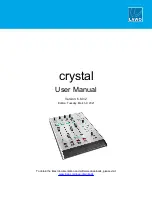
1-49
IM 04L42B01-01E
Overview of Functions
1
2
3
4
5
6
7
8
9
10
11
12
13
App
Index
• Computation Data Dropout
A computation data dropout occurs if the computation is not completed within the scan
interval. For the operating procedure, see section 9.4.
• The computation icon in the status display section turns yellow.
• When a computation data dropout occurs, the computed data of the scan interval in
which the dropout occurred is set to the data immediately before the dropout.
• If computation data dropout occurs frequently, lessen the load on the CPU by
reducing the number of computation channels or setting a longer scan interval.
• Numeric Display and Recording
The range of displayed values of computed data is from –9999999 to 99999999
excluding the decimal point. The decimal place corresponds to the decimal place of
the lower limit span of the computation channel. On the numeric display, values are
displayed if the computed result is within the above range regardless of the upper and
lower limits of span. The following table indicates special displays.
Display/Recording
Computed Data Status
+Over
• +Display over: When the computed result exceeds 99999999
• +Computation over: When the value exceeds approximately
1.79E+308 in the middle of the computation
• When a computation error* occurs (Over or –Over.)
–Over
• –Display over: When the computed result is less than –9999999
• –Computation over: When the value is less than approximately
–1.79E+308 in the middle of the computation
• When a computation error* occurs (Over or –Over.)
* Computation error occurs when the following computation is carried out.
• X/0, SQR(–X), or LOG(–X)
• If a channel number set to skip or Off is used in the equation
• Rolling Average
The rolling average of the computed result of the equation specified for the
computation channel is determined, and the result is the computed data for that
channel. The number of samples and the sampling interval can be specified for each
computation channel. The rolling average is applied over the time corresponding to “the
number of data samples × the sampling interval.” The maximum sampling interval is 1
hour, and the maximum number of samples is 1500.
• Starting the Computation
You can configure the DX to start the computation when you press the START key.
• Usage of TLOG Computations
TLOG computation determines the sum, maximum, minimum, average, or the
difference between the maximum and minimum of a specific channel for each interval
determined by a timer.
Timers That Are Used
The timer that is used is assigned to each channel.
Unit of Sum Computation
Set the sum scale when using sum computation (TLOG.SUM).
Select Off, /s, /min, or /h. For details, see page 1-51.
1.8 Computation and Report Function (/M1 and /PM1 Options)
Summary of Contents for Daqstation DX2000
Page 2: ......
Page 98: ...Blank...
Page 132: ...Blank...
Page 224: ...Blank...
Page 292: ...Blank...
Page 324: ...Blank...
Page 348: ...13 24 IM 04L42B01 01E 13 7 External Dimensions See the DX2000 Operation Guide IM04L42B01 02E...
Page 366: ...Blank...
















































